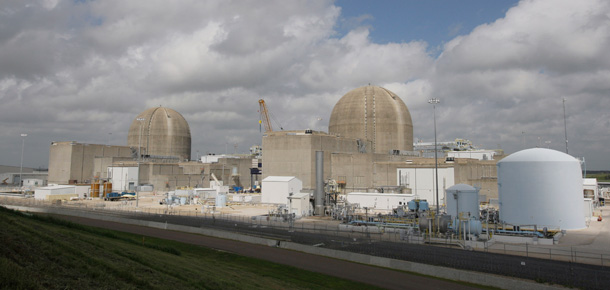
Different parts of the Nuclear Regulatory Commission took opposite positions this month on how the agency will enforce its Atomic Energy Act-mandated rules prohibiting “foreign ownership, control or domination” of U.S. nuclear reactors, known as FOCD in agency parlance.
The NRC staff had joined with intervenors, including the SEED Coalition and Public Citizen Texas, challenging the license of the proposed South Texas nuclear project, which is owned by a consortium called NINA (Nuclear Innovation North America), which is composed of NRG Energy and Toshiba. Tokyo Electric Power originally was a member of the consortium but was forced to drop out of the project after the onset of the Fukushima nuclear disaster. But NRG Energy–the lead partner at the time–also said it was dropping out of the project and stopped providing any funding for it after spending some $480 million in its initial stages. That left Toshiba holding the bag and keeping the project’s funding going. But although it stopped funding the project, NRG never formally left the consortium even though its CEO, David Crane–hardly an anti-nuclear advocate–has said repeatedly in public that no new reactors will be built in deregulated markets like Texas.
The NRC staff and intervenors argued in licensing proceedings that while NINA remained mostly owned by a U.S. corporation (NRG Energy), Toshiba–by providing and controlling the money–effectively controlled and dominated the project.
But according to an article in the Houston Business Journal, the Atomic Safety and Licensing Board ruled against the staff and intervenors and said Toshiba, despite its funding dominance, “is not in a position to control or dominate decisions related to nuclear safety, security, or reliability” and somehow apparently found that Toshiba doesn’t have financial control over the project despite being the only entity still providing funds.
We say “apparently” because the actual full decision of the ASLB has not yet been publicly released. According to the ASLB, the decision contains proprietary business information (i.e. information on Toshiba and NRG’s investments in the project) that has to be reviewed by attorneys for all sides and likely deleted before a public version will be released.
The NRC’s blog attempted, but largely failed, to make sense of the ASLB’s rejection of the position taken by intervenors and the agency’s own staff. It’s true, however, that it is difficult to make sense of it at all without being able to read the actual decision.
Even then, the decision is likely to result in scratched heads and raised eyebrows for those of us who have been following this issue closely. Although the facts are somewhat different from the Calvert Cliffs-3 proceeding where NIRS (also joined by NRC staff) successfully challenged the project for its FOCD violations, the principle established in that case seems clear to us, as does the Atomic Energy Act: foreign companies simply cannot own, control or dominate U.S. reactor projects.
The Calvert Cliffs decision also directed the NRC staff to review its FOCD regulations. That review was supposed to be completed by December 31, 2013, but that and a subsequent new deadline were missed. The staff’s recommendations are now expected any day. We will, of course, provide a speedy analysis of the staff’s recommendations and reasonings.
In any case, the odds that the ASLB decision will result in the actual construction of new reactors at South Texas are slim. As noted, NRG Energy doesn’t believe new nuclear reactors can be economically viable and certainly isn’t going to build any itself; indeed, since Fukushima NRG has changed its business model and is focusing heavily on advancing solar power and distributed generation generally. By holding on to its stake in the consortium, NRG now could attempt to try to sell its piece based on the favorable ASLB decision. But it’s unlikely any other potential buyer will see the electricity landscape in Texas any differently than NRG. Wind, solar power and natural gas are all growing rapidly in Texas and in the state’s deregulated marketplace all three can provide power much more cheaply than new reactors could–making them unlikely prospects for new investment. And, of course, the Calvert Cliffs decision prevents the option of Toshiba taking full ownership of the project itself.
And any potential investors also have to deal with the prospect of an appeal of the ASLB decision by either or both intervenors and NRC staff, which under NRC’s somewhat strange rules, cannot occur until the ASLB has completed the entire proceeding and approved a license for the project–and that’s still about two years away.
Disclosure: The attorney for the intervenors in this case is Bob Eye, who is a member of NIRS’ Board of Directors.
Michael Mariotte
April 29, 2014
Permalink: https://www.nirs.org/2014/04/29/nrc-sends-mixed-signals/
You can now support GreenWorld with your tax-deductible contribution on our new donation page here. We gratefully appreciate every donation of any size–your support is what makes our work possible.
Comments are welcome on all GreenWorld posts! Say your piece above. Start a discussion. Don’t be shy; this blog is for you.
If you like GreenWorld, you can help us reach more people. Just use the icons below to “like” our posts and to share them on the various social networking sites you use. And if you don’t like GreenWorld, please let us know that too. Send an e-mail with your comments/complaints/compliments to nirs@nirs.org. Thank you!
Note: If you’d like to receive GreenWorld via e-mail daily, send your name and e-mail address to nirs@nirs.org and we’ll send you an invitation. Note that the invitation will come from a GreenWorld@wordpress.com address and not a nirs.org address, so watch for it.




I have just come from a memorial service for nuclear power/weapons. There were no grieving relatives in attendance. The minister’s parting words were drowned out by the sound of workmen installing solar panels and windmills on an adjacent lot. Afterwards we all bicycled to a nearby pub and had a cold one, brewed by a local company.
Don Richardson gaia@comporium.net The country that most threatens US security is…….the US.